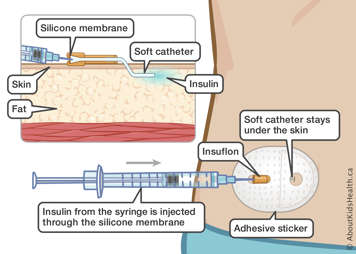There are many devices that try to help make injections easier. However, none takes away the need for an injection itself. Before you spend any money on any injection aid, talk to your diabetes team.
No device eliminates the need for a needle
If your child wants an injection aid to reduce pain, remind them that all injections hurt a little. If the injection is more painful than usual, try to:
- check the needle; there may be a defect
- insert the needle quickly; inserting the needle slowly hurts more
- push the plunger in a little more slowly — this will reduce any burning sensation
- take the insulin out of the refrigerator some time before the injection to let the insulin warm up — children say they can feel cold insulin being injected
- pinch the skin less tightly
- try a different injection site.
If none of this works, talk to your diabetes nurse about the selection of injection sites, different kinds of needles and other tools that may be helpful.
Insertion aids
If your child is bothered by manually inserting a needle, a spring-loaded device can be useful. With the push of a button, the needle of an insulin-filled syringe is quickly inserted in under the skin. Then simply push the plunger of the syringe to inject the insulin.
Insuflon and i-Port
Insuflon
An insuflon is a small catheter that is inserted through the skin into the fat that stays in place for up to four days. It is held in place by an adhesive sticker. The insuflon requires a needle for catheter insertion. Insulin is injected via a syringe through the silicone membrane on the insuflon and reaches the fat layer without the needle having to pierce the skin. Therefore, insuflon is a more pain-free alternative to daily injections through the skin.

I-Port
An i-Port, like an insuflon, places a cannula under the skin through one needle. An i-Port uses an “inserter” that places the thin cannula in the skin. The insulin can then be injected through the cannula with a regular syringe and a needle that never pokes the skin.